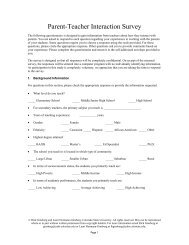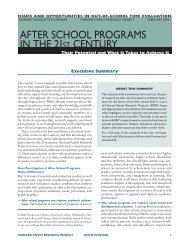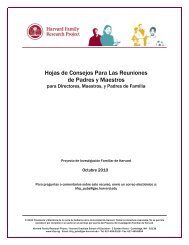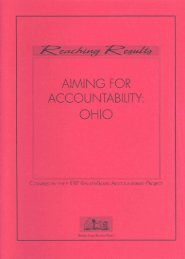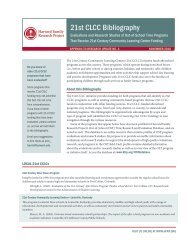Download a PDF of this case study - Harvard Family Research Project
Download a PDF of this case study - Harvard Family Research Project
Download a PDF of this case study - Harvard Family Research Project
Create successful ePaper yourself
Turn your PDF publications into a flip-book with our unique Google optimized e-Paper software.
Begin with a Solid <strong>Research</strong> Base<br />
Since 1981, Epstein and her colleagues have been initiating their own research, as well as<br />
reviewing the research <strong>of</strong> others, to form a solid research base for the Network. Epstein<br />
has used these research findings in several important and strategic ways. First, she has<br />
argued convincingly for family-school-community partnerships by pointing to decades <strong>of</strong><br />
“first generation” research on the benefits <strong>of</strong> family involvement to students and others<br />
(e.g., Epstein, 1995; Henderson & Berla, 1994). Second, Epstein has demonstrated the<br />
need to build schools’ capacity for family-school-community partnerships by highlighting<br />
studies that reveal school-level barriers to partnership and how they can be overcome.<br />
These barriers include the lack <strong>of</strong> staff training (e.g., U.S. Department <strong>of</strong> Education, 1997),<br />
different ways that families and schools conceptualize family involvement (e.g., National<br />
PTA, 1997), and negative attitudes or lack <strong>of</strong> confidence among school personnel<br />
(Epstein, 1991; New Futures Institute, 1989; Fine & Vanderslice, 1990). At the same time,<br />
other studies have shown that schools can overcome these barriers and foster<br />
relationships with families (Epstein & Dauber, 1991; Sanders & Epstein, 2000). Finally,<br />
since 1995, Epstein, Assistant Director Mavis Sanders, and their colleagues have<br />
conducted research on specific patterns <strong>of</strong> partnership, program implications, and the<br />
success <strong>of</strong> organizational supports. This work has provided additional information on how<br />
to build schools’ capacity for partnership work with all families.<br />
Specifically, the Network’s mission <strong>of</strong> building schools’ capacity is fueled by research on<br />
the patterns <strong>of</strong> family involvement and supportive school practices. Epstein synthesizes<br />
her own and others’ research on family involvement to draw the following conclusions<br />
about partnership patterns and program implications (Epstein, 1995; Epstein, Coates,<br />
Salinas, Sanders, & Simon, 1997):<br />
• Partnerships tend to decline across the grades, unless schools and teachers work<br />
to develop and implement appropriate practices <strong>of</strong> partnership at each grade<br />
level.<br />
• Affluent communities currently have more positive family involvement, on<br />
average, unless schools and teachers in economically distressed communities<br />
work to build positive partnerships with their students’ families.<br />
• Schools with more economically depressed communities make more contacts<br />
with families about the problems and difficulties their children are having, unless<br />
they work at developing balanced partnership programs that include contacts<br />
about positive accomplishments <strong>of</strong> students.<br />
• Single parents, parents who are employed outside the home, parents who live far<br />
from the school, and fathers are less involved, on average, at the school building,<br />
unless the school organizes opportunities for families to volunteer at various times<br />
and in various places to support the school and their children (Epstein, 1995, p.<br />
703).<br />
Epstein also concludes from research that families, schools, and students are all<br />
motivated to work together for children’s success:<br />
• Just about all families care about their children, want them to succeed, and are<br />
eager to obtain better information from schools and communities so as to remain<br />
good partners in their children’s education.<br />
• Just about all teachers and administrators would like to involve families, but many<br />
do not know how to go about building positive and productive programs and are<br />
consequently fearful about trying. This creates a “rhetoric rut” in which educators<br />
are stuck, expressing support for partnerships without taking any action.<br />
- 4 -





